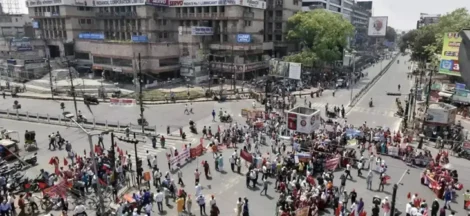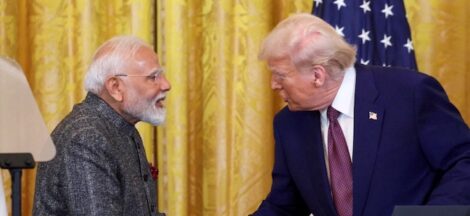By Anjan Roy
Without declaring it, war has effectively broken out between India and Pakistan. The hostilities have spun out of control as both countries have expanded their targets spread far out into the country.
Witness the cycle of escalation. Foreign secretary, Vikram Misri, stated the terror attack at Pahalgam on April 22 was the “first escalation.” India responded with detailed war plan with its targets for nine terror camps in Pakistan, including those deep inside Punjab on May 7.
Pakistan has last night (May 8) mounted attacks on fifteen towns and cities along the 3000-kms odd border. India rammed down Pakistani missiles with advanced surface to air missiles (Sam 400s).
Then India has pumped missiles into the air defence systems and military facilities in Pakistan military bases including those in Lahore, Rawalpindi and Sialkot, major bases of Pak army and air force. India has disabled the air defence systems of major bases —including Lahore— in Pakistan.
There are even more sinister possibilities. Pakistan has alleged India was seeking to demolish the Neelam-Jhelum dam in Pakistan which was foiled. When pointed out this allegation, foreign secretary, Misri, alleged this was a ploy for Pakistan to attack some of India’s dams upstream, then he cited these would be replied in equal measure.
Besides, India had let loose another weapon this time: waters from upstream dams. Reports indicate waters from some western rivers are likely to arrive Punjab province later tonight.
Now that these responses are out of control, there are no cushions available to soften up the clashes. With the United States following a different theory of its role in policing the world, there will be little attempts to cool down tempers and responses. US vice president, J.D. Vance, has completely distanced US from the conflict, saying this was none of their “wars”.
The dangers are the mind of Panjabi Muslim “phelelwani” psychology that does not take into account consequences and irresponsibly to a situation of pique. “Meri nak cut gaya, hum revenge lenge”, as articulated by a retired Indian army general in a TV discussion. Perhaps this gives a clue to the real problem.
Pakistan government has now empowered the Pak military to respond to India’s moves in whatever manner it thinks fit. This is a clear indication of larger escalation of the hostilities between the two countries.
India today has entered the second phase of the hostilities, responding to Pakistan’s move last night to mount attacks on sixteen military installations from Srinagar and Avantipura in the north to Bhuj in the south along the Indo-oak border and some further deeper into the country.
Jammu, Pathankot, Jalandhar, Adampur, Bathinda, Amritsar, Nal are some of the military centres which were targeted. These were responded with direct strikes at critical military bases in Pakistan, including Lahore, and of all places Pakistan army headquarters in Rawalpindi in response to Pakistan’s attempts to hit the military facilities inside the country.
This conflict so far gives insights and lessons to the art of warfare in the twenty-first century. The importance of the technology available cannot be over-emphasised, but the airdefence systems are the shield for protecting people in general as well as the military assets.
The Pak air attacks were repelled with the use of surface to air missiles (SAM) systems SAM-400 weapons systems which were one of the best in class in the world. Incidentally, the American were piqued when India chose the Russian systems in preference to some offered by Americans.
Additionally, India confirmed attacks on military centres in Pakistan with drones which had played havoc with these facilities. The attacks are widening across the country and Pakistan has stopped all flights in the country.
India has attacked Lahore cantonment, Sialkot and a cricket stadium adjoining Rawalpindi army headquarters, indicating that it can directly hit the Army headquarters as well.
The hits and counter-hits this time mark a departure from previous cycles of such hostilities. This is the first time that India has imposed a heavy cost on Pakistan for its temerity to attack Indians on its territory with infiltrated militants. Obviously, Pakistan did not calculate that the responses could be this heavy handed.
Despite these early Indian successes, India is also incurring heavy costs, though the New Delhi officials are not specific on these costs. In these critical times when the global economy is restructuring its supply chains and investment directions, and India was emerging as a hot spot from locating new manufacturing facilities and investments, these have received a rude shock from the current round of hostilities.
Given the initial success in thwarting the Pak intrusions, India must be mature and keep it long term interests in mind in deciding future course of action. After all, the primary objective at this point of time would be to keep intact the Indian economic story. Our development process must not be disturbed.
Behind our military offensive —and let there be no let up in scoring decisive victories to ensure long term gains— India should work for a short duration confrontation.
India’s journey to a mature economy with manufacturing sinews and trade could be deferred by years until these confrontations come to a quick end. Prospects for early end to hostilities look grim, as the intervention structures available previously are absent. (IPA Service)




 Xi-Putin Declaration In Moscow On The Eve Of Victory Day On May 9 Has Major Geopolitical Significance
Xi-Putin Declaration In Moscow On The Eve Of Victory Day On May 9 Has Major Geopolitical Significance 